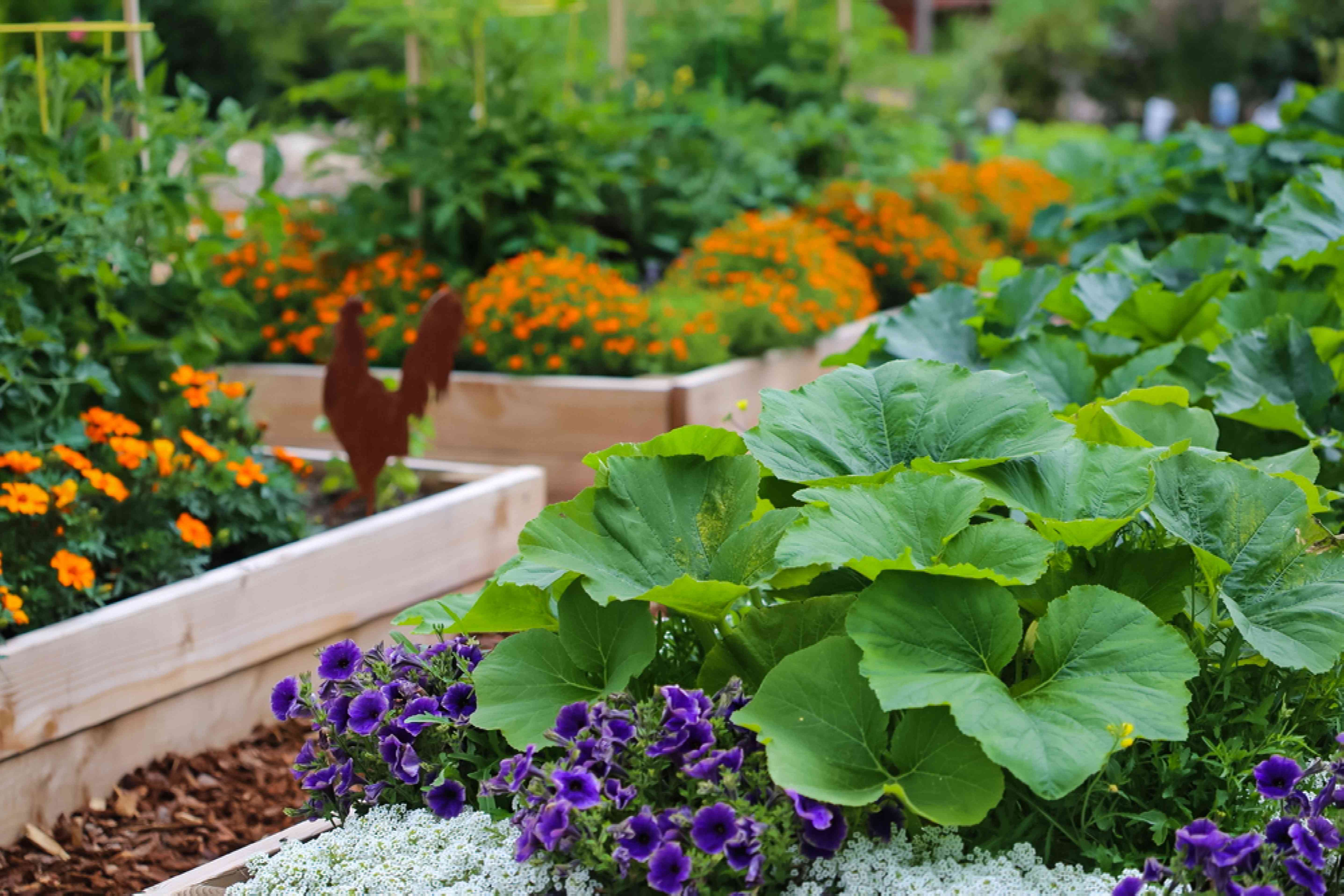
×

Vegetable gardening at home has many advantages! Firstly, it allows you to grow fresh and healthy food right in your backyard. You can enjoy the taste of homegrown vegetables, which are often more flavorful than store-bought ones. Gardening also teaches you about nature and the environment, as you learn how plants grow and the importance of caring for them. It's a fun and rewarding activity that keeps you active and helps reduce stress. Plus, growing your own vegetables saves money and promotes sustainability by reducing the need for transportation and packaging. So, grab your gardening tools and get ready to enjoy the benefits of homegrown veggies!
Vegetable garden design is a truly fun activity to organize your at-home vegetable plants. Fresh veggies with a practical and aesthetically pleasing vegetable garden design are great additions to a house to make it feel like a home. Here are a few tips on how to nail good vegetable garden designs in small spaces:
1. Vertical Gardens: Utilize vertical space by growing vegetables on walls or trellises. You can hang planters or use a pallet garden to grow herbs and smaller veggies like lettuce and cherry tomatoes.
2. Window Boxes: Install window boxes outside your windows or on balcony railings to create a mini vegetable garden. Plant herbs, salad greens, or compact vegetables like radishes and dwarf varieties of peppers.
3. Container Gardening: Use pots, buckets, or any available containers to grow vegetables. Opt for compact varieties such as patio tomatoes, dwarf beans, or bush cucumbers. Ensure proper drainage and sufficient sunlight for healthy growth.
4. Hanging Baskets: Hang baskets filled with trailing vegetables like cherry tomatoes or strawberries. They not only save space but also add a decorative touch to your garden.
5. Raised Beds: Build raised beds to maximize space and improve soil quality. Fill them with nutrient-rich soil and plant a variety of vegetables such as carrots, lettuce, spinach, and herbs.
6. Edible Walls: Create a living wall by planting herbs, lettuce, and other greens in wall-mounted pockets or modular systems. It's a creative way to grow your own food and decorate your space.
7. Companion Planting: Combine different vegetables and herbs that grow well together to maximize space. For example, plant lettuce under taller plants like tomatoes to make use of the vertical space and provide shade to the lettuce.
8. Hanging Herb Garden: Hang a vertical herb garden using repurposed materials like shoe organizers or a wooden ladder with pots. This allows you to have a variety of herbs easily accessible in a small space.
9. Salad Bowl Garden: Plant different lettuce varieties, spinach, radishes, and herbs in a large container or trough. This way, you can harvest fresh ingredients for salads in one convenient space.
10. Windowsill Garden: Utilize your windowsills to grow herbs like basil, mint, or parsley. They require minimal space and can be easily accessed for cooking or garnishing dishes.
Read Also: Dry Climate Gardening
When planning vegetable garden designs, there are a few key factors to keep in mind to ensure your plants have enough space to grow and thrive. Here are some tips to help you create a creative vegetable garden design:
1. Sunlight: Most vegetables need at least six hours of direct sunlight each day. Choose a location in your garden that receives ample sunlight and avoid planting near tall trees or structures that may block the sun.
2. Soil Preparation: Remove weeds, pebbles, and garbage from your soil. Add compost or organic matter to improve soil fertility and drainage. Loose and well-draining soil is essential for healthy plant growth.
3. Plant Spacing: Different vegetables have different spacing requirements, so it's important to give each plant enough space to grow. Leave adequate space between plants to allow air circulation and prevent overcrowding, which can lead to disease and poor growth. Consult seed packets or gardening guides for specific spacing recommendations.
4. Companion Planting: Some plants grow well together and can benefit from being planted near each other. For example, planting marigolds among your vegetables can deter pests. Research companion planting combinations to maximize the health and productivity of your garden.
5. Crop Rotation: Rotate your vegetable crops each year to prevent soil nutrient depletion and reduce the risk of pests and diseases. Avoid planting the same sort of food in the same location year after year.
6. Watering: Provide regular and consistent watering to keep your plants hydrated. Water deeply at the base of the plants, preferably in the morning or evening when temperatures are cooler. Overwatering can cause root rot and other issues, so avoid it.
7. Pathways: Leave enough space between garden beds for easy access and maintenance. Wide enough pathways allow you to walk, water, and harvest without damaging your plants.
8. Succession Planting: To maximize your harvest, consider succession planting. This means planting new seeds or seedlings as soon as a crop is harvested, allowing you to have a continuous supply of fresh vegetables throughout the growing season.
Creating a vegetable garden in your backyard can be an exciting and rewarding project. Here are some simple and fun design ideas to help you get a creative vegetable garden design:
1. Raised Beds: Build raised beds using wooden planks or bricks to create defined growing areas. This design not only adds visual appeal to your backyard but also helps with soil drainage and prevents soil compaction.
2. Vertical Gardening: Make use of vertical space by growing vegetables on trellises, fences, or using hanging planters. This design saves space and allows vining plants like tomatoes, cucumbers, and beans to grow upwards.
3. Container Gardens: Utilize containers such as pots, buckets, or even recycled items like old tires or barrels to grow vegetables. This design is ideal for small spaces or if you have limited soil access. Plus, containers can be easily moved around for better sun exposure.
4. Keyhole Garden: Create a keyhole-shaped garden bed by placing a circular or horseshoe-shaped raised bed with a small pathway in the middle. This design maximizes planting space and provides easy access to all plants.
5. Square-Foot Gardening: Divide your garden into square-foot sections using wooden planks or strings. This design allows for precise spacing and organization, making it easier to manage and maintain your vegetable garden.
6. Herb Spiral: Build a spiral-shaped garden bed with different levels using stones or bricks. Plant herbs like basil, thyme, and mint in the various tiers, creating a visually appealing and functional herb garden.
7. Theme Gardens: Get creative with themed vegetable gardens, such as a pizza garden (with tomatoes, peppers, and herbs) or a rainbow garden (with colorful vegetables like carrots, beets, and bell peppers). This design adds a playful element to your backyard and makes gardening more enjoyable.
8. Pathway Patterns: Design pathways between your garden beds using materials like gravel, stepping stones, or mulch. Experiment with different patterns or shapes to add visual interest to your vegetable garden.
Remember, the most important thing is to have fun and enjoy the process of designing and growing your backyard vegetable garden. Get creative, try different ideas, and don't be afraid to make adjustments along the way. Happy gardening!
Here's a simple vegetable garden layout plan for a standard backyard or small space:
1. Location: Choose a sunny area in your backyard that receives 6-8 hours of sunlight per day.
2. Raised Beds: Create three rectangular raised beds using wooden planks or bricks. Each bed should be 3 feet wide and 6 feet long.
3. Bed 1: Plant tomatoes on one end of the bed, spacing them 2 feet apart. In the middle section, plant bell peppers with 1-foot spacing. At the other end, plant a row of basil plants.
4. Bed 2: Divide this bed into two equal sections. In the first section, plant bush beans with 6-inch spacing. In the second section, plant rows of lettuce with 1-foot spacing.
5. Bed 3: Divide this bed into three equal sections. In the first section, plant cucumbers along a trellis. In the second section, plant zucchini with 2-foot spacing. In the third section, plant rows of carrots with 4-inch spacing.
6. Pathways: Leave 1.5-foot-wide pathways between the beds for easy access and maintenance.
7. Herbs and Flowers: Plant a row of marigolds along the edges of the beds to deter pests. Interplant herbs like parsley and cilantro throughout the garden to attract beneficial insects.
8. Watering: Install a drip irrigation system or water by hand as needed. Ensure each plant receives sufficient moisture.
9. Mulching: Mulch the soil around the plants with straw or wood chips to conserve water and suppress weeds.
10. Maintenance: Regularly monitor for pests and diseases. Remove weeds and provide support for vining crops as they grow.
Remember to adjust the plan based on the specific requirements of the vegetables you choose to grow and the available space in your backyard. Happy gardening!
Image Source- pexels.com
Written by- Ananya Majumdar
.